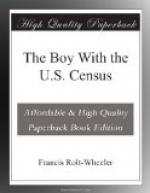“My word,” Hamilton exclaimed, “what a storage you must have!”
“You ought to go down and see it some time,” the other said. “It’s big enough, with every State and every county and every district in the country having its own place, and every little village in that district right where it belongs in a box of its own, under that State, county, and district. I’m telling you this just to show you that we don’t have to sort the cards for location at all, and that in itself saves us a lot of labor and time.”
“And they were sorted into sexes on the punching machine, I remember,” Hamilton remarked.
“Yes, and that prevents another handling of every card, you see,” the chief went on, “so that without any further special division, every card is divided by village, district, county, and State, as well as sex, when it leaves the punching machine From there it comes to the tabulating machine—which is just the same as the verification, only instead of the electrical connections being made through relays only, they are sometimes made direct to counters.”
“Just how, Mr. Cullern?” the boy asked.
“Well,” the other continued, “when the pin, passing through the hole in the card, drops into the little cup of mercury it closes a current passing through an electro-magnet controlling a counter or a dial corresponding with each possible item of information on the card, and for each contact made to each dial, an added unit is registered. The tabulating process is completed by an automatic recording and printing system, somewhat along the stock ticker plan, connected with each dial. When desired, touching an electric button will cause every dial to print automatically the number recorded on a ribbon of paper.”
“That is before sorting?”
“Or after. Cards may be tabulated along a lot of different lines. And the sorting device depends again upon another machine, operated by the same principle.”
The chief led the boy to another portion of the floor.
“This sorter,” he said, “can be set for thirteen different compartments. In determining the country of birth, for example, at any given point on the card, an electrically charged brush finds the hole punched and directs the card in between two of those finely divided wire levels, where a traveling carrier picks it up and runs it along to the point where the wires stop, the top wire extending to the furthest compartment. As the card falls, it is tilted into place against the pile of preceding cards, an automatic receiver holding them together, the operator clearing away the pile from each division as it becomes full. As you can see, that feed knife moves so rapidly and the endless band fingers carry the cards out of the way in such a hurry that they move along in a steady stream. We have only twenty of these machines and they handle all the cards.”
“It’s hard to believe,” said Hamilton wonderingly, “that these machines don’t think.”




